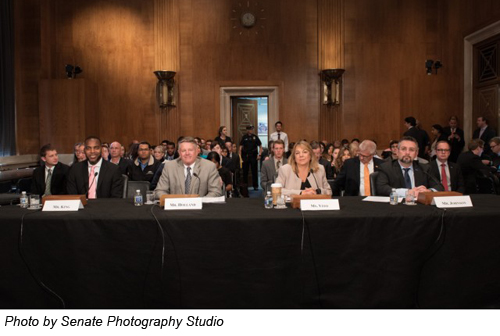 I recently had the privilege of offering testimony before the United States Senate Committee on Health, Education, Labor, and Pensions (HELP) in Washington, DC related to the expansion of apprenticeship programs designed to create new opportunities. I was testifying on behalf of Associated Builders and Contractors (ABC), a national construction trade organization with 21,000 members, through the lens of my experience with MAREK. I was joined by three others who spoke from alternate perspectives about the value of apprenticeships and their views on the Department of Labor’s “Registered Apprenticeship Programs” versus “Industry Recognized Apprenticeship Programs," whether the industry recognized programs are duplicative of the registered programs, and whether there are gains to be achieved by using both programs more fully.
I recently had the privilege of offering testimony before the United States Senate Committee on Health, Education, Labor, and Pensions (HELP) in Washington, DC related to the expansion of apprenticeship programs designed to create new opportunities. I was testifying on behalf of Associated Builders and Contractors (ABC), a national construction trade organization with 21,000 members, through the lens of my experience with MAREK. I was joined by three others who spoke from alternate perspectives about the value of apprenticeships and their views on the Department of Labor’s “Registered Apprenticeship Programs” versus “Industry Recognized Apprenticeship Programs," whether the industry recognized programs are duplicative of the registered programs, and whether there are gains to be achieved by using both programs more fully.
“Registered Apprenticeship Programs” have been in place for many years and are endorsed by the Department of Labor. “Industry Recognized Apprenticeship Programs,” known as IRAPs, which have also been around for many years, have only recently been branded as "IRAPs" in conjunction with the newly-formed Task Force on Apprenticeship Expansion created to respond to the president’s executive order on the expansion of apprenticeship programs.
According to the U.S. Bureau of Labor Statistics, the United States currently has approximately 6.6 million job openings and the lowest unemployment rate in twenty years, leaving many employers struggling to find enough qualified workers to meet their demand. This was the driving reason for the president’s executive order, and the Senate HELP hearing was in response to the task force’s recent recommendations for the expansion of apprenticeship programs.
Committee Chairman Senator Lamar Alexander, a Republican from Tennessee, opened the hearing with an overview of our robust economy and outlined the struggles he was hearing about from employers in his home state. Next was the opening statement by the ranking Democrat Senator Patty Murray of Washington. It was clear the supporters of Registered Apprentice Programs were still smarting from the implications of the executive order and the accompanying recommendations. Three of the four witnesses present to provide information clearly indicated a preference for the innovation made possible through a more flexible approach granted with IRAPs. These witnesses included Montez King, Executive Director of National Institute for Metalworking Skills; Glenn Johnson, Workforce Development Leader of BASF Corporation and me. Furthermore, our testimony focused on the bureaucracy and burden associated with registered programs that has led to diminished participation in these programs.
The fourth witness, Sandy Vito from the Service Employees International Union (SEIU), represented an intermediary organization (Local 1199 SEIU) and the Healthcare Career Advancement Program (H-CAP). She spoke to the success they had experienced utilizing a Registered Apprenticeship model. Much of her testimony indicated the use of best practices in training and strategic partnership and some of the recent upgrades the DOL had put in place. The majority of the committee’s questions were from the Democrats and were directed toward Ms. Vito/SEIU which seemed to illustrate the success of Registered Apprenticeship Programs. Repeatedly I heard Registered Apprenticeship Programs described as the gold standard, having been in place for a hundred years and offering worker securities.
The interesting benefit, both from the testimony and the question and answer period, was the clear focus on the best practice aspects of workforce development, rather than the “vehicle,” whether Registered or IRAP, that the workers were enrolled in. While the undertone was clearly aimed at justifying the Registered Apprenticeship Program’s place as the de-facto standard, every single example of a successful initiative, program, or partnership was rooted in innovation and contained clear deliverables.
 What was less clear was the specific role the aspect of “Registered” played in that success. In fact, the IRAP programs described by the other witnesses, whether specific or anecdotal, contained every element in the Registered programs, minus the oversight and bureaucracy. Features like clear wage progression, job placement, and credentials were highlighted. Regarding “worker security,” I am unclear what securities a Registered Apprenticeship Program affords the participants that a successful IRAP does not, especially given the fact that all employers are mandated by the DOL to follow wage and hour laws, EEOC, and other well-known employment laws.
What was less clear was the specific role the aspect of “Registered” played in that success. In fact, the IRAP programs described by the other witnesses, whether specific or anecdotal, contained every element in the Registered programs, minus the oversight and bureaucracy. Features like clear wage progression, job placement, and credentials were highlighted. Regarding “worker security,” I am unclear what securities a Registered Apprenticeship Program affords the participants that a successful IRAP does not, especially given the fact that all employers are mandated by the DOL to follow wage and hour laws, EEOC, and other well-known employment laws.
While the president’s task force included representatives from numerous industries and organizations, including those that value registered programs, the Democrats on the Committee seemed to take the bipartisan and common-sense recommendations as a threat to the established registered system. This could not be further from the truth and our goal, and the goal of the taskforce, is to improve both our registered and industry recognized programs to provide a more successful delivery method to educate our workers on the skills they need to succeed.
The president’s executive order and the subsequent task force recommendations represent a great opportunity for all of us to take an in-depth look at the way we envision and provide education and skills for our potential workforce candidates. Such an in-depth look does not presume failure if we ultimately find recommendations for positive change; nor does it represent duplication of effort if we recognize and adopt those recommendations for change that improve the programs.
We must move past the “if it ain’t broke don’t fix it” mentality and get our act together to help American workers, businesses, and our economy prosper. I don’t care what we call it.

